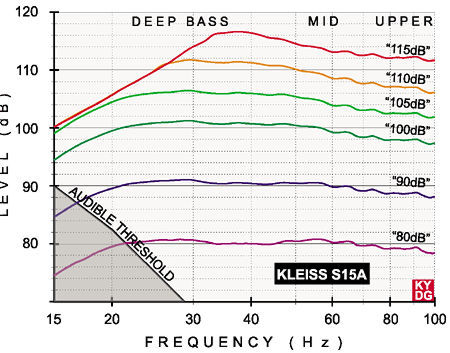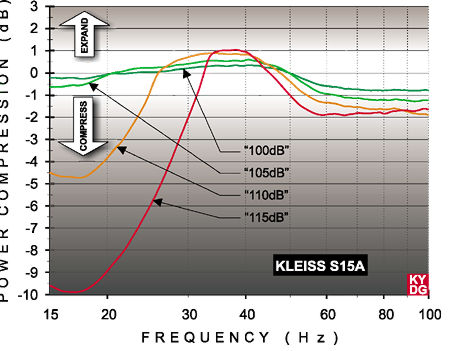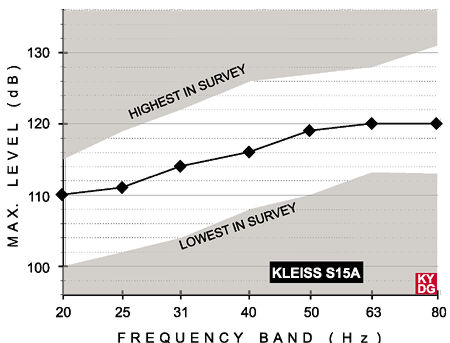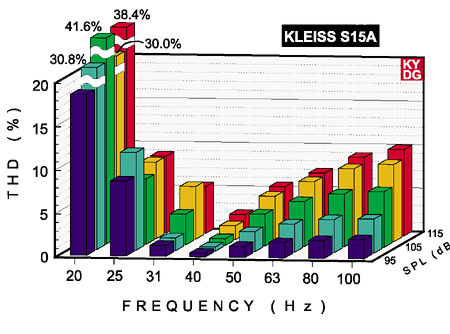Way Down Deep I Kleiss S15A
Geoff Franklin is an AV installer whose client list reads like Who's Who in Hollywood and Silicon Valley. He's one of the most plugged-in guys I know, and when he called with a report on a new subwoofer that had engineers at Dolby and Skywalker pulling out their personal checkbooks, I pulled out my notepad. The sub in question is the S15A, manufactured by Kleiss Sound of Sausalito.
Measurements
Frequency response at 80dB (Fig.9): 20–80Hz, +/-0.8dB; -2.5dB at 18Hz..

Fig. 9: Frequency Response vs Output
Frequency response at higher levels: Driving the sub 10dB harder, to a nominal 90dB at 1m, produced a result that was within roughly +/-0.6dB of the 80dB curve, just offset 10dB higher (Fig.9). The +/-3dB tolerance window was met up to and including a nominal playback level of 110dB as measured at 1m. At the highest level (nominally 115dB at 1m), the response showed some peakiness between 32 and 46Hz, falling off at slightly more than 12dB/octave below 30Hz, but still managing to meet its advertised +/-3dB window down to 26Hz.
Dynamic range: The compression curves (Fig.10) show the S15A's natural "eagerness" to play the 32–46Hz range, which it effectively amplified by about 1dB relative to the 90dB baseline irrespective of playback level. At the highest (115dB) drive levels, compression whittled about 5dB out of the 20Hz response at the nominal 110dB level, and about 9dB at the 115dB level; i.e., the response of the S15A at 20Hz never exceeded about 104dB, regardless of how hard I pushed it.

Figs. 10: Power Compression
The shaped tone-burst graph (Fig.11) shows that the S15A was capable of producing more undistorted short-term output at the test frequencies than the majority of the other contenders in this survey. In general, the Kleiss's ranking relative to its competitors improved as frequency decreased. Only two of the dozen subs surveyed got the better of it at 20Hz.

Fig. 11: Shaped Tone-burst Peak Output
Total harmonic distortion: Coming up big at the very bottom end usually comes at a price: distortion. While THD throughout the 25–100Hz range never exceeded 10% no matter how hard I drove it, at 20Hz it came close to 20% even at the relatively modest level of 95dB, and increased at higher playback levels (Fig.12).

Fig. 12: Total Harmonic Distortion vs Frequency & Level
The audibility of THD depends on factors beyond the scope of this article. My desire to bring the level-vs.-distortion tradeoff to some kind of real-world resolution was the primary reason I relied on my ear rather than the oscilloscope to judge the onset of distortion in the shaped tone-burst tests. As previously noted, the frequency-response graph (Fig.9) shows that the S15A hit its max at around 106dB at 20Hz, while the shaped tone-burst graph (Fig.11) shows that the unit's undistorted peak was around 110dB at the same frequency. The discrepancy is partly due to the short-term nature of a tone burst, which gives higher peak readings than the long, slow sweeps at the heart of the frequency-response tests.
The S15A made a subtle but audible hiss-like noise when driven hard with pure tones (sinewaves) in the low bass. This appeared to come from a small air leak at one of the audio input receptacles on the back of the cabinet. Company owner Tai Kleiss appeared to be aware of the issue and said the problem affected only early-production units, an issue that has been solved in current production. I have not tested or verified this.
Listening
That final T. rex clomp barely a minute into "Jurassic Lunch," from Telarc's Great Fantasy Adventure CD, is pure low-end torture: It's deep (down to 10Hz), it's loud; it's long; and, probably most terrifyingly, there's precious little going on in the rest of the audio range to mask the distortion created by the convulsive cone movements required to capture it. The Kleiss coped with the clomp up to a clean peak of 100dB, the same as the Revel B15, before signaling that enough was enough. Although the peak levels were the same, the Kleiss seemed to impart a slightly more vivid sense that the ground was being shaken—something that can be made out, with a little squinting, in the slightly higher-energy density below around 19Hz in the accompanying waterfall plots (Figs.A1, A2, and A4).
 The depth charge 1:19:50 into U-571 is one of several hull-wracking monsters. The explosions are most intense in the 40–45Hz range, but strong recorded energy extends down to 13–16Hz (Figs.B1 and B4). The Kleiss managed an undistorted peak of 109dB in this clip. Holding that volume setting and reconnecting the main speakers led to a broadband C-weighted peak level of 114dB and an average level of 100dB during this scene—a sufficiently lifelike playback level to suck everyone but the hard-of-hearing into the action. Response below roughly 17Hz was too weak at any playback level to impart the sense that the blast was actually deforming the hull.
The depth charge 1:19:50 into U-571 is one of several hull-wracking monsters. The explosions are most intense in the 40–45Hz range, but strong recorded energy extends down to 13–16Hz (Figs.B1 and B4). The Kleiss managed an undistorted peak of 109dB in this clip. Holding that volume setting and reconnecting the main speakers led to a broadband C-weighted peak level of 114dB and an average level of 100dB during this scene—a sufficiently lifelike playback level to suck everyone but the hard-of-hearing into the action. Response below roughly 17Hz was too weak at any playback level to impart the sense that the blast was actually deforming the hull.
As can be seen in the frequency-response graphs and waterfalls, the S15A's ability to manage a little better than 100dB at 18Hz proved especially useful in the Black Hawk Down clip (Figs.C1 and C4), where it contributed to an authentically ominous roar as the choppers were fired up. That dark rumble is more than just gratuitous: It sets the audience up for something sinister or tragic to come.
It feels a bit unfair to report that the chopper landing in Apocalypse Now Redux and the chopper explosion in The Matrix lacked a bit of realism in the extreme bottom end. No commercial cinema I've been in has ever developed 100dB at 20Hz at my seat, something the Kleiss and several others in this survey could manage without self-immolation. (The speaker setups in most commercial cinemas sound scrawny at 30Hz, let alone 20Hz; what passes for wallop in a cinema is usually snappy dynamics in the 35–50Hz range.)
The S15A came up just short of convincing on the admittedly cartoonish pod-racer crash in the Phantom Menace tunnel scene. My notes referred to the likely utility of adding another unit to achieve a more natural, unforced quality to the transient peaks. There was a frisson of high-frequency fuzz floating on top of the bass-drum whack in Holst's First Suite when played at concert or near-concert levels. This probably connects back to the small leak mentioned in the previous section.
I had no such nits to pick with "March of the Exorcists" from the Casper soundtrack, Béla Fleck's "Cosmic Hippo," or Holly Cole's "Jersey Girl." The S15A played all of these without a hint of subwoofer "personality"—no idiosyncratic spectral balance to plump up or thin out instrumental timbres, no boxy coloration or dynamic constriction or additive distortion to announce.
The Bottom Line
That the Kleiss S15A will no longer remain anonymous to the sub-buying public is almost a certainty. Seeming to come out of nowhere, the S15A arrives as an impressively designed, robustly built subwoofer that delivers close to reference-class bass at a factory-direct price.
Price aside, in some ways it might be viewed as an industrial-strength cousin of the Revel Performa B15: Both rely on a 1kW amplifier and a sealed, compact, solidly built cubic cabinet housing a proprietary, long-throw, 15-inch driver. Both include onboard parametric EQ—though the Kleiss's is a single-band to the Revel's three. The Kleiss is ever so slightly beefier in every respect: size, weight, output. What it lacks—nice wood finishes and styling touches to "residentialize" it, and the prospect of auditioning it at your local retailer—it makes up for in bang for the buck. For just under $5000, you could have two of them, and you'd be in for a treat. You'd also be in on something before the rest of the world catches on.
Specifications
Kleiss S15A powered subwoofer
Driver: 15" carbon- and resin-reinforced paper cone, linear peak-to-peak excursion of 2.5", cast aluminum frame, 50 lbs total weight
Frequency response: 16–150Hz, +/-3dB
Inputs: RCA (single-ended)
Outputs: XLR (balanced), RCA (single-ended)
Amplifier: 1kW RMS, 2kW peak
High-/lowpass filters: 40–100Hz, 24dB/octave (lowpass defeatable)
Phase: continuously variable, 0–180°
Other: single-band parametric equalizer
Weight: 120 lbs
Dimensions: 20" x 20" x 21" (HxWxD)
Finishes: flat black; add $350 for piano black
Price: $2449
Kleiss Sound
(415) 381-0800
www.kleissound.com
- Log in or register to post comments



































































